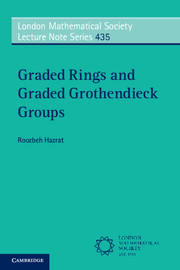6 - Graded versus nongraded (higher) K-theory
Published online by Cambridge University Press: 05 May 2016
Summary
Recall that for a Γ-graded ring A, the category of finitely generated Γ-graded projective right A-modules is denoted by PgrΓ-A. This is an exact category with the usual notion of a (split) short exact sequence. Thus one can apply Quillen's Q-construction [81] to obtain K-groups
Ki(PgrΓ-A),
for i ≥ 0, which we denote by Kigr (A). If more than one grading is involved (which is the case in this chapter) we denote it by KiΓ (A). The group Γ acts on the category PgrΓ-A from the right via (P, α) ↦ P(α). By the functoriality of K-groups this gives Kigr
(A) the structure of a right ℤ[Γ]-module.
The relation between graded K-groups and nongraded K-groups is not always apparent. For example, consider the ℤ-graded matrix ring
A = M5(K)(0, 1, 2, 2, 3),
where K is a field. Using graded Morita theory one can show that K0ℤ (A) ≅ ℤ [x, x-1] (see Example 3.7.3), whereas K0(A) ≅ ℤ and K0(A0) ≅ ℤ×ℤ×ℤ×ℤ (see Example 1.3.6).
In this chapter we describe a theorem due to van den Bergh [20] relating the graded K-theory to nongraded K-theory. For this we need a generalisation of a result of Quillen on relating Kigr -groups of positively graded rings to their nongraded Ki-groups (§6.1). We also need to recall a proof of the fundamental theorem of K-theory, i.e., for a regular Noetherian ring A, Ki(A[x]) ≅ Ki(A) (§6.2). We will see that in the proof of this theorem, graded K-theory appears in a crucial way. Putting all these together, we can relate the graded K-theory of regular Noetherian ≅-graded rings to their nongraded K-theory (§6.4).
As a conseqeunce, we will see that if A is a ℤ-graded right regular Noetherian ring, then one has an exact sequence (Corollary 6.4.2),
where U is induced by the forgetful functor (§1.2.7).
- Type
- Chapter
- Information
- Graded Rings and Graded Grothendieck Groups , pp. 205 - 226Publisher: Cambridge University PressPrint publication year: 2016



